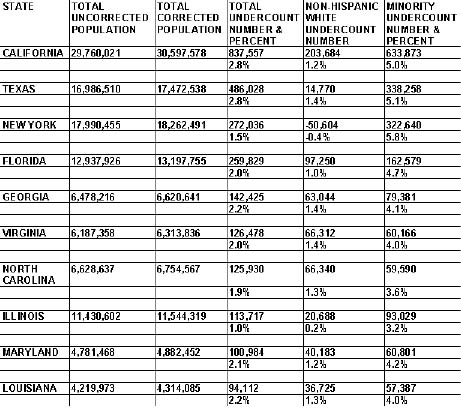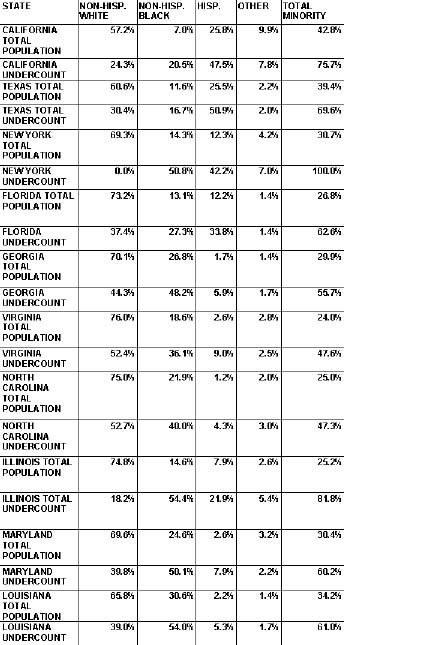|
Introduction:
The Undercounting of Minorities in the United States Census
It
is not possible to count fully and accurately the population of a large and
diverse nation. No matter how heroic their efforts, census takers inevitably
miss some persons who should be counted. Other persons may be double-counted
and the enumeration process itself may erroneously add persons to the count.
The net undercount is the difference between persons missed in the census
and persons double-counted or erroneously included.3 Since 1940,
the Census Bureau has acknowledged a net undercount that is not randomly distributed
across the population. The undercount, measured in percentage terms, is substantially
larger for minorities than for whites. The differential undercount for minorities,
moreover, is not a function of the total undercount in the population. In
1940, the net undercount for the population was 5.4 percent, compared to less
than 2 percent for 1980 and 1990. Yet the differential undercount of about
4 percentage points between whites and non-whites has not varied significantly
during this 50-year period.4
Traditional
census procedures are not effective in reducing the differential undercounting
of whites and minorities. According to recent studies conducted by two panels
of the National Academy of Sciences, "differential undercounting cannot
be reduced to acceptable levels at acceptable costs without the use of integrative
coverage measurement," which is a statistical sampling method that adjusts
census data for the undercount. Three panels of the National Academy of Sciences
recommended including such an adjustment in order to create the most accurate
possible census and to reduce the differential undercounting of whites and
minorities.5
Although
census data corrected for such statistical sampling were not included in the
official data released for redistricting purposes in 1991, the Census Bureau
did eventually report the corrected numbers, which substantially reduced the
undercounting of minorities. Table 1 demonstrates that for each state studied,
the percentage undercount of members of minority groups is substantially higher
than the percentage undercount of non-Hispanic whites. In one state _ New
York _ the 1990 Census even slightly overcounted non-Hispanic whites, despite
undercounting members of minority groups. Table 2 demonstrates that the undercounted
population in each instance includes a much greater percentage of minorities
than a state's overall population.
The
failure to adjust for the undercounting of minorities in the drawing of legislative
districts can affect opportunities for minority voters to participate fully
in the electoral process and elect candi dates of their choice to legislative
positions. Differences in the numbers and percentages of minorities can be
significant in areas of minority concentration, where legislative districts
with substantial percentages of minorities are drawn. Given differences in
the candidate preferences of white and minority voters, small differences
in the minority composition of districts can be consequential for the opportunity
for minorities to elect candidates of their choice in such districts.
TABLE
1.
The state-by-state analysis that follows below will explore the implications
for minority voter opportunities of using corrected as opposed to uncorrected
data from the 1990 Census. At the time of the completion of this report, the
Census Bureau had not yet released the block level data used for the post-2000
redistricting and other purposes. Existing legislative districts, however,
serve as a baseline against which to assess minority voter opportunities when
new districts are created in each state. For those involved in drawing redistricting
plans, the 1990 experience can also be an important guide for assessing the
impact on minority voter opportunities of the use of corrected versus uncorrected
data for the post-2000 redistricting.


This analysis will
not attempt to redraw legislative district plans or demonstrate that a shift
to corrected data in the post-1990 redistricting process would necessarily have
produced different configurations of districts. It does not suggest that districts
should be based primarily on race. It does not attempt to reassess comprehensively
the redistricting plans of the states included in the study. No claim is made
here that the districts identified in the state-level analyses are the only
ones in which there had been a potential to enhance minority-voting strength.
Rather the analysis explores only whether the use of corrected data would have
had the potential to expand minority voter opportunities in the post-1990 redistricting.
The analysis is limited to plans drawn statewide for Congress, State Senates
and State Houses of Representatives. It should be noted, however, that as compared
to such statewide redistricting plans, the use of corrected census data would
likely have had an even greater potential impact on the relatively less populous
districts drawn for municipal and county governments within each state. The
web site of the National Committee for an Effective Congress (NCEC) provides
data on the demographic composition of each state's congressional, state senate,
and state house districts.6 For states that have altered their district
plans during the 1990's, the NCEC data is for the most recently available plan.
District maps are available from the NCEC and from the web sites of most state
governments.
|
|
|





